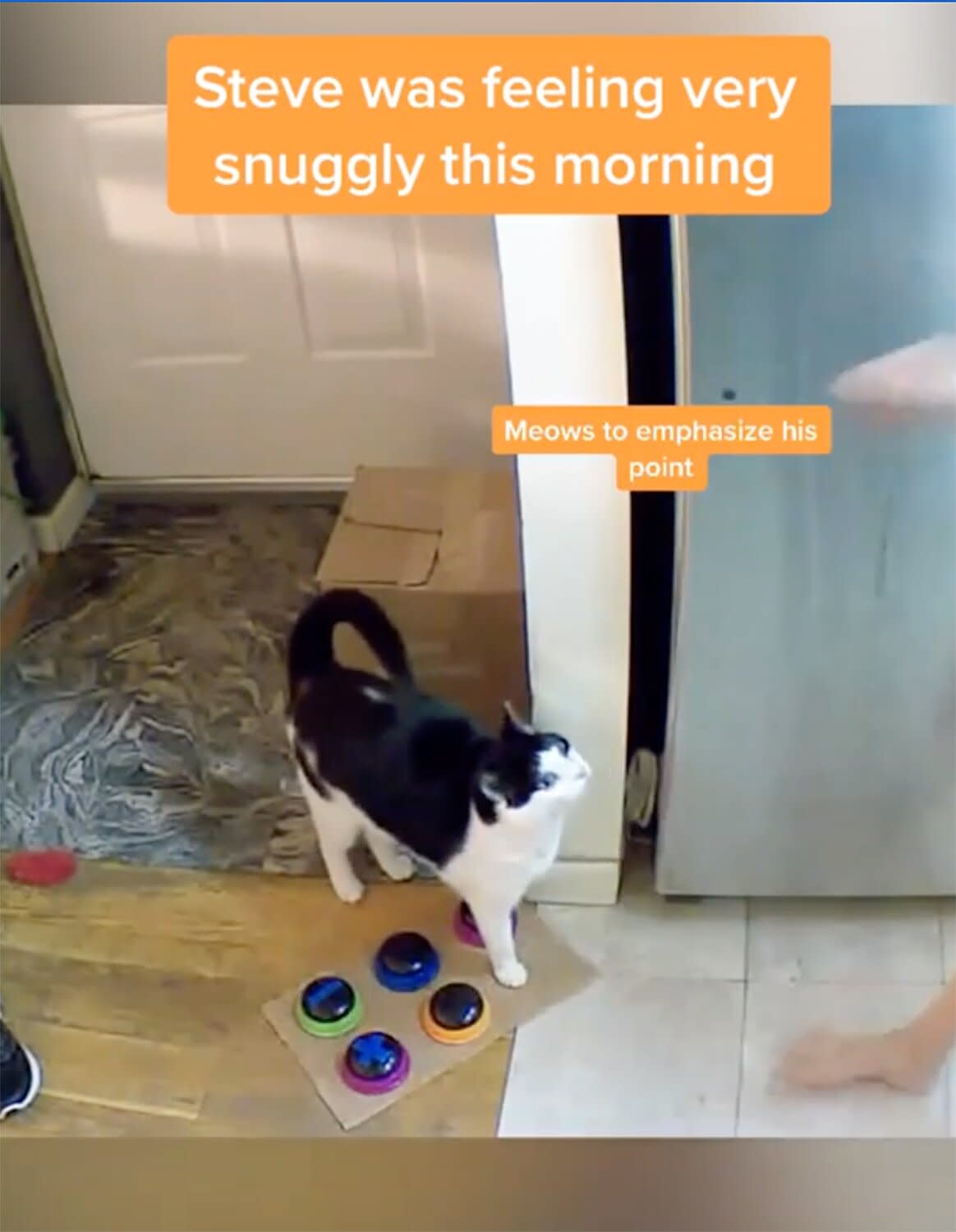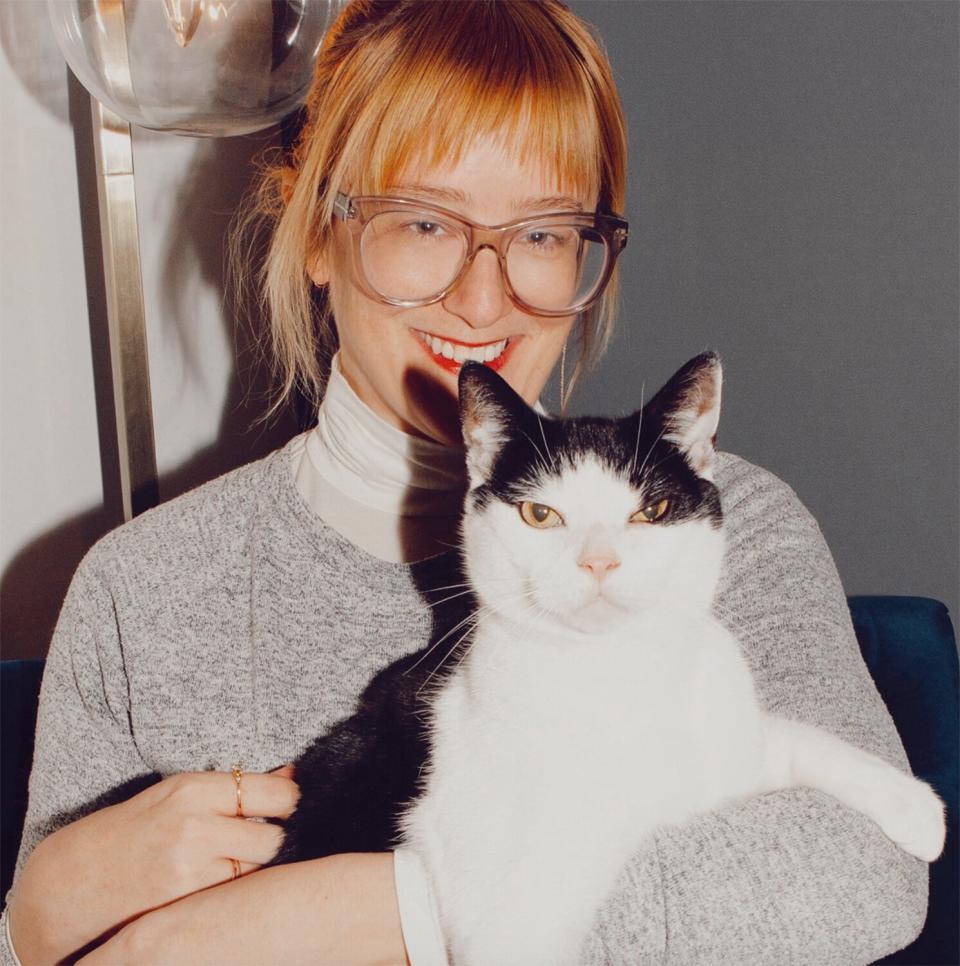Steve the Cat Uses Talking Buttons to Ask for Food, Snuggles, 'Kittynip,' Outdoor Time and More

The Daily Steve B/Instagram
Kristiina Wilson, an animal behaviorist in New York City, has worked with cats for more than 20 years. But one of her 9 pet felines, Steve, was a special guy from the get-go.
The newborn kitten of a feral mama cat Wilson was socializing at the time, Steve "came out exactly how he is now," she recalls to PEOPLE. "He was clearly a very special dude, very different and very awake, and he ended up staying here and ruling the house."
These days, Steve, now 11, has a new trick up his sleeve: He's learned how to communicate with Wilson and her wife using a soundboard made up of programmed oversized buttons that feature recordings of Wilson speaking words like "outside" and "eat." Similar to Stella the dog, of the now-famous Hunger for Words Instagram account, Steve was trained to ask for things by stepping on the colorful buttons.
The humble Steve B. now has thousands of fans on Instagram and TikTok — which is where Wilson first noticed animals using the talking buttons.
"During COVID, my master's thesis work got shut down, and I was just sitting around bored," Wilson says. (She's currently finishing her master's program in animal behavior and conservation at Hunter College.) "I downloaded TikTok and I saw some animals using the buttons, and was like, ‘Oh, I bet Steve could do this. Let's mess with it,'" she explains.
RELATED: Dog Learning to Talk with Custom Soundboard: 'I'm in Constant Amazement'
Though she says it generally takes animals about a month to learn the buttons, Steve mastered them in only 4 days. "Steve is not a cat. He's like a person dressed in a cat's body. He's been screaming at me since he was born and being very clear about his needs and wants."

Tayler Smith Kristiina Wilson with Steve
Though none of the couple's other cats have followed Steve’s lead in mastering buttons, Wilson says the other kitties "clearly understand what the buttons are; when Steve pushes one, they all come to get the thing that he's pushed."
Wilson chronicles Steve’s daily antics on Instagram at @thedailysteveb and @theboredbehaviorist, as well as @StinkTok on TikTok. And Steve is a constant communicator — he uses his buttons to ask for catnip, food, snuggles, and outside time (the couple has an enclosed yard).
"I started off with the 'outside' button because going outside is his highest motivator," Wilson says. "He just loves to be outside. He sits out there and stares at birds and screams at people."
RELATED: Duo, a Tiny Black Kitten Born with 2 Faces, Overcoming the Odds with Vet Owner's Care
Steve also regularly uses his "snuggle" button to ask for pets; he is "the most affectionate cat I've ever met in my life," Wilson notes. She also recently introduced new buttons for "kittynip" and "lady" — Wilson’s name for herself — which allows Steve to address his human directly when he wants something.
RELATED: Stella the Dog 'Talks' About Social Distancing, Coronavirus
Want to teach your cat to use buttons? According to Wilson, it’s a process called modeling: "You record the button with your voice saying the thing —in this instance, let’s say catnip. You make sure they're watching you hit the button with your foot, then you do the action it represents. So you hit 'catnip', take the catnip out, and give them the catnip."
You do this over and over until the animal (hopefully) begins to understand the correlation and starts pressing the buttons himself. "Whenever you're responding to them, you also repeat the modeling. So if he asks for catnip and then I give him catnip, I hit 'catnip' again while I'm giving it to him to reinforce what that button is for," Wilson explains.
She notes the entire process isn't quite the same as "talking," because, as massively intelligent as Steve may be, he doesn't speak English. "This is associative concept learning. It's not speech. It's basically like ringing a bell on a door to go outside," Wilson says.
But if using buttons encourages people to spend more time with their pets, to think about their cognitive abilities, to "engage with them and enrich their life more," Wilson says, she "thinks that's awesome."

